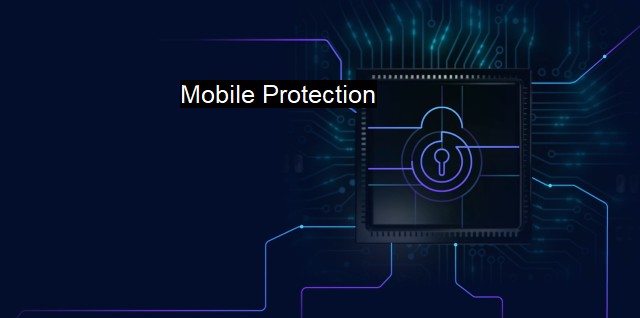What is Mobile Protection?
Protecting Your Mobile Device: Importance of Cybersecurity Measures in Today's Digital Landscape
Mobile protection refers to the measures and methods utilized to safeguard mobile devices from a myriad of potential threats, such as viruses, malware, phishing attacks, and hacking attempts that seek unauthorized access to personal or confidential data. It factors into the wider cybersecurity landscape and constitutes a crucial lynchpin in ensuring safety in the digitized, constantly-connected reality of the 21st century.Fundamental to mobile protection is understanding the threats it contends with. Primarily, these threats revolve around attacks targeting confidential information stored within the device. Viruses, for instance, can infect the device corrupting data while also opening backdoors for additional malware or more targeted attacks. Similarly, malware can monitor user activity and steal personal data. Apps and websites can also harbor threats, ranging from apps with dangerous permissions to phishing websites, aiming to trick users into revealing sensitive information like passwords and credit card numbers.
To counter these concerns, cybersecurity professionals and software vendors continuously develop and update several types of mobile protection. Antivirus software is perhaps the most well-known protective measure. Many antivirus programs are multi-faceted – they not only identify and eliminate viruses, but also function as anti-malware, ant-spyware, and anti-phishing tools, guarding against an array of other threats. Increasingly, GDPR compliance tools – equipped to pick up on potential privacy concerns, especially on apps requiring unnecessary permissions – are coming incorporated into software packages.
Protection methods are not solely confined to software-based efforts. Many cybersecurity guidelines underscore the importance of constant updating of mobile operating systems and apps, as software updates often incline towards patching security vulnerabilities along with enabling new features. Likewise, securing Wi-Fi and other connections and guarding against any suspicious network behavior is indispensable for robust mobile protection.
Data encryption serves as another pivotal way to defend against uninvited access. By rendering data unreadable without the correct decryption key, encryption offers potent defense against potential data breaches. Two-factor and multi-factor authentication feature as significant ancillary measures, introducing extra layers of required proof for access.
Going a step further, enterprises commonly rely on mobile threat defense (MTD) solutions. These take a more comprehensive view and look for vulnerabilities in an organization's own network while stopping threats at the device level.
Delving into this, Mobile Device Management (MDM) systems emerge as a form of mobile protection aimed particularly at enterprises. MDM solutions allow IT teams to control corporate devices to some extent, restricting their use and installing and updating necessary protections. Many solutions include the ability to remotely wipe a device's data should it get compromised or lost.
Nonetheless, no protection can truly be complete without digitally-literate users. Cybersecurity education serves as a potent protection method in its own right – teaching people about common threats, explaining phishing methods, and creating awareness about ill-advised internet behavior is as meaningful as the most sophisticated software or regulatory framework.
While hard to quantify, human error is often the most significant factor in successful cyber-attacks, acknowledging this will ensure that each user takes due responsibility personally.
Mobile protection gravitates centered on being a multifaceted, constantly evolving area, merging both technical and human aspects. As we steadily venture deeper into a connected era, the spectrum of risks broadens, making the demand for adequate mobile protection measures more pressing. Whether considering individuals seeking to guard their personal information on their phones or businesses aiming to protect their confidential data within their networks, the stroke of essences to 'Mobile protection" is simple – it’s all about safeguarding data and privacy in the digital age.

Mobile Protection FAQs
What is mobile protection?
Mobile protection refers to the measures taken to keep your mobile phone safe from cyber-attacks, viruses, and other malicious software. This can include installing antivirus software, setting up 2-factor authentication, and being mindful of the apps you download and the links you click on.Why do I need mobile protection?
Mobile protection is essential because cyber-attacks on mobile phones are becoming increasingly common. Hackers can gain access to your personal information, steal your identity, and cause financial harm. Protecting your mobile phone can help prevent these types of incidents.How can I protect my mobile phone?
There are several ways to protect your mobile phone, such as installing antivirus software, using strong and unique passwords, avoiding public Wi-Fi, and being cautious when downloading apps or clicking on links. You should also update your mobile phone and apps regularly, and enable security features such as fingerprint recognition or facial recognition.What should I look for in a mobile protection app?
When looking for a mobile protection app, you should consider features such as antivirus protection, malware detection, phishing protection, and firewall protection. You should also look for an app that is compatible with your mobile phone's operating system, has a user-friendly interface, and provides timely updates. Additionally, you may want to consider the cost of the app and any additional features it may offer, such as a VPN service.| | A | | | B | | | C | | | D | | | E | | | F | | | G | | | H | | | I | | | J | | | K | | | L | | | M | |
| | N | | | O | | | P | | | Q | | | R | | | S | | | T | | | U | | | V | | | W | | | X | | | Y | | | Z | |
| | 1 | | | 2 | | | 3 | | | 4 | | | 7 | | | 8 | | |||||||